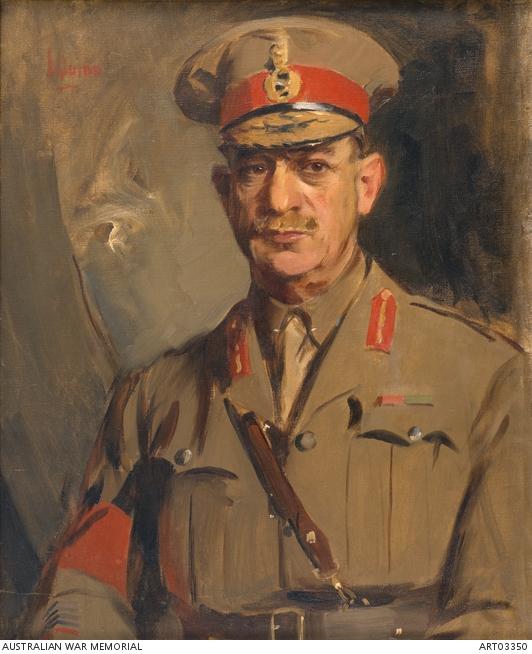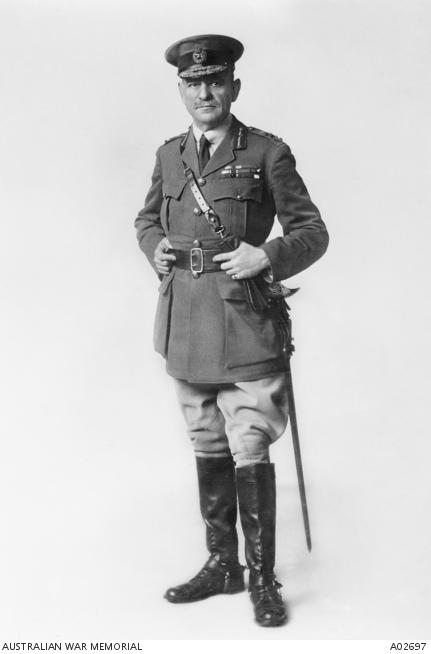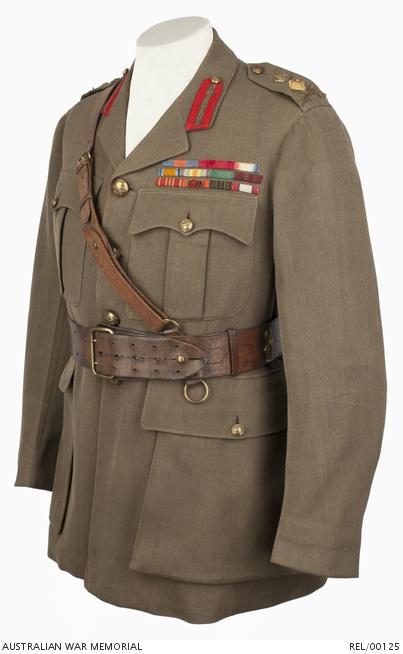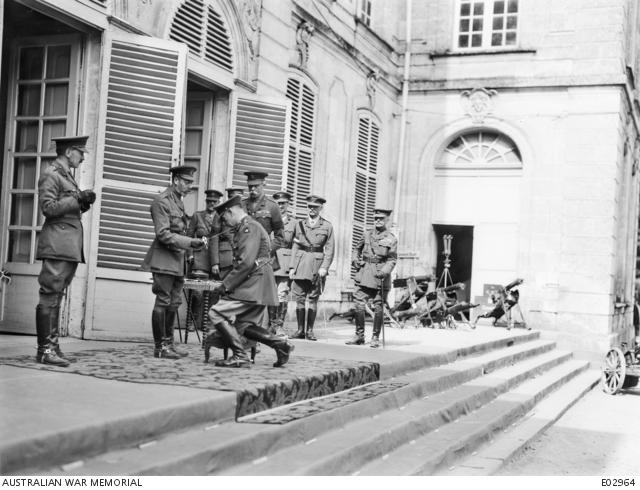The inner Monash
Except for sportsmen or bushrangers, few Australians have achieved legendary standing in their own country. Sic gloria transit mundi, a Latin phrase that encapsulates the ephemeral nature of fame, usually applies to prominent Australians once they have exited the national stage. John Monash has fared better than most. Before the First World War, he was a leading engineer and citizen soldier. During the war, he held senior command in the Australian Imperial Force (AIF). After the war, he planned and oversaw the AIF’s return home and was responsible for the development of Victoria’s power scheme. A Canberra suburb, a Melbourne university, a ship and many buildings have been named after him. Recent hagiographies have credited him with winning the war and shaping Australia. Monash’s name may not be instantly recognisable like Don Bradman’s or Ned Kelly’s, but he has hardly been forgotten.

John Longstaff, Lieutenant General Sir John Monash, (1919, oil on canvas, 120 x 92 cm). AWM ART02986
Monash’s fame rests mainly on his achievements as commander of the Australian Corps during the advance to victory in 1918. As he had previously led the 4th Brigade on Gallipoli and the 3rd Division in France, his ideas on fighting were fully developed. They harnessed every technological resource – artillery, tanks, aircraft – to relieve the infantry as much as possible, as he put it, of “the obligation to fight its way forward”. Using this approach in his first operation as corps commander, the attack at Le Hamel in July 1918, Monash took the concept of the all-arms battle to a new level in the British Expeditionary Force (BEF). It was a great success and became the model for the bigger British offensives that followed. At Mont St Quentin in September, Monash excelled in one of the Western Front’s rare manoeuvre battles. He then drafted the plan for the Fourth Army’s attack on the Hindenburg Line, in which his corps had a leading role.
Monash is the only Australian general with an international reputation. The eminence he attained led the Australian Official Historian, Charles Bean, and others to work out the sort of man he was. This process illuminated Monash’s personal strengths and weaknesses. The war may have brought them into relief, but he was still essentially the man that he had always been.

Group portrait of Lieutenant General Sir John Monash KCB, with General Pau and members of the French Mission about to leave for Australia, in the grounds of Corps Headquarters. Back row, left to right: Major Burr; Captain Simonson; unidentified; Brigadier General T. A. Blamey CMG DSO; unidentified; unidentified. Front row: unidentified; unidentified; Gen Monash; Gen Pau; unidentified. E02751
Starting well before the war, Monash prepared a daily agenda, on which he crossed off each completed task with horizontal and vertical lines and linked the vertical lines to make a continuous line. Gaps remaining signified outstanding tasks and they headed the next day’s agenda. A few minutes were allowed here and there in case a task went longer than planned, and for relaxation. Before going on leave during the war, Monash would draw up a list of what he intended to take. Once packed, items were deleted from the list – again with horizontal and vertical lines. When all the vertical lines were connected, he knew that he had packed everything. An inveterate collector, he had amassed a vast collection of photographs, souvenirs and personal papers by the end of his life. Whenever possible, he spent his Sundays cataloguing them so that he could always lay his hands on whatever item came to mind.
Meticulousness also characterised Monash’s operational planning. “Every detail had been thought of,” wrote Field Marshal Sir Douglas Haig, the BEF’s Commander-in-Chief, after Monash’s briefing for the 3rd Division’s first big attack, on the Messines ridge, in June 1917. Thirty-six instructions set the details out. “You never saw such a document,” recalled Major General Charles Harington, the Second Army’s Chief of Staff. Monash's agenda for the final conference before the Le Hamel attack listed 133 items, from the arrangements for spare Lewis guns and water supply, to the equipment of the assaulting troops. Haig was again greatly impressed, calling Monash “a most thorough and capable commander who ... leaves nothing to chance.” His words had a familiar ring. Monash’s orders as commander of the North Melbourne Battery between 1896 and 1908 were “models of conciseness and at the same time completeness”, a fellow militia officer said. “Nothing was overlooked.”

Portrait of Lieutenant General Sir John Monash, one of Australia's most distinguished soldiers during the First World War. During his Army career, General Monash was Colonel Commanding the 13th Infantry Brigade of the Citizen Forces, Commander of the 4th Infantry Brigade at Gallipoli, Commander of the 3rd Australian Division in France 1916-1918 and Commander of the Australian Corps from 31 May 1918 until after the Armistice. A02697
Occasions such as conferences demonstrated Monash’s articulateness. As an expert witness in legal engineering cases before the war, his penetrating lucidity was always apparent. Failing to retain him was regarded in some legal quarters as tantamount to negligence. Major General Sir Herbert Cox, Monash’s divisional commander in Egypt after Gallipoli, never missed an opportunity to attend Monash’s brigade briefings “simply for the educational value and pleasure of hearing him speak”. Even Bean, whose relations with Monash were uneasy, admitted that listening to him was an absorbing experience. In 1919 Monash punched out a memoir, The Australian victories in France in 1918, in one month. The hand-written draft needed little amendment before publication, further proof that Monash was a clear thinker who could effortlessly communicate his thoughts. Haig, who could not express himself coherently, and the 1st Australian Division’s commander at the start of the war, Major General William Bridges, whose conversational trademark was a grunt, contrasted starkly with him.
Whereas Major General Sir James McCay, his prewar school chum and militia contemporary, made imbeciles feel like imbeciles, Monash made them feel like geniuses. Unlike Bridges, he never spoke down to people and had a gift for putting them at ease. “Sit down and be comfortable – would you like a cigarette?” Monash told Lieutenant Harold Lilya, a well-known fighting officer from the 3rd Division, before telling him what he wanted. Lilya remembered his charm and informality sixty years later. Unlike Lieutenant General Sir William Birdwood, his predecessor as commander of the Australian Corps, Monash did not chaff soldiers. It was not his style and he knew that they would see through him. It was not Haig’s style either, and the result when he tried it was embarrassing. “You have run very well,” he said to the winner of a cross-country race. “I hope you run as well in the presence of the enemy.” Birdwood’s banter, like so much else with him, was superficial and often misfired. “How’s your father?” was a standard Birdwood line. “Still dead, sir” came the deadpan reply from one officer. Monash had a sense of theatrical occasion, but it is hard to imagine him making such a faux pas.

Service dress tunic worn by Lieutenant General Sir John Monash, c 1916 AWM REL/00125
Monash’s degrees in engineering, arts and law from Melbourne University, and pre-war work as a pioneer of reinforced concrete construction in Australia, attested to his intellect. The artist Arthur Streeton deemed him “undoubtedly the greatest brain in Australia”. Monash’s engineering outlook quickly led him to the nub of a problem and to the solution. With the Australian Corps facing a long assault in the climactic offensive on 8 August 1918, he reversed the order of the assembly, placing the divisions attacking last closest to the start line, where they would be leapfrogged by the ones assaulting first. Those divisions would then be leapfrogged in turn. The innovative manoeuvre worked flawlessly, ensuring fresh troops at each stage. Monash drafted the main elements of plans himself. When staff officers handed him lists of points to be attended to, he would often give them his list, which contained twice as many points as theirs. The 3rd Division’s director of medical services remarked after his first meeting with Monash: “Damn it, I began to wonder if I knew anything at all about medicine.”
When war came, Monash was a self-made millionaire. Starting with his parents’ penury, his life had been a battle against adversity. Success in business, with profit the Micawberish determinant of happiness, eluded him for years. A staggering output of work went into his eventual triumph and it did not diminish afterwards. Hard work, study and concentration were, for him, the keys to success. It was impossible to be too busy: “you can always find time to do one thing more,” he would say. This background was reflected during the war in two ways. Focused solely on winning the war, he drove both himself and the Australian Corps hard. When it finally left the line in October 1918, it was badly depleted and totally exhausted. Monash’s ability before the war to persist despite spirit-sapping difficulties, showed robustness – the capacity to endure great strain and to make quick and clear decisions – which is the essence of generalship. It was evident on Gallipoli, where Monash was the only brigade commander to serve almost continuously from the Landing to mid-September.
Robustness permitted the ruthlessness that was sometimes necessary. “You must get yourself into a callous state of mind,” Monash told the officers of the 3rd Division. “Hypnotise yourself into a state of complete indifference over losses.” At Messines and Passchendaele, he called down barrages to retain ground thought to be held, despite the possibility that his own men might be underneath. He was willing to sacrifice a pioneer battalion to keep the road open for the armoured cars on 8 August 1918, and during the Mont St Quentin attack he told Major General John Gellibrand, his successor as commander of the 3rd Division, to take Bouchavesnes spur regardless of casualties, as success depended on it. As the battle ground on, the pleas of Major General Talbot Hobbs, commander of the 5th Division, and others that their men were worn out fell on deaf ears. But Monash always balanced the importance of the objective against the anticipated cost of achieving it. He initially refused to attack at Le Hamel because of concerns over losses. In all of Australian Prime Minister William Hughes’s dealings with generals, Monash was the only one who seemed to him to weigh up the cost of victory.

His Majesty King George V, knighting Lieutenant General Sir John Monash outside the Australian Corps Headquarters at Bertangles, France, 12 August 1918 AWM E02964
In Australian victories Monash bared his true feelings about the war after it was over: “Every day was filled with loathing, horror and distress. I deplored all the time the loss of precious life.” During the war he only let his guard down to those close to him, confiding to one friend of long standing that he was training newly-arrived reinforcements so that “in a month or two they may with all due circumstance, get blown into little pieces or get holes drilled into themselves for the honour of Australia and for the good of posterity.” The men were never disposable commodities to him; he treated them with genuine humanity. “I am nothing but a mere brigadier-general,” Monash admonished a young soldier who had failed to salute him, but one day, Monash continued, a fire-eating second-lieutenant would come along and the result of such a lapse would not be pleasant. At the theatre while on leave, Monash sat next to an AIF sergeant and private and invited them to have a drink with him during the interval, to the dismay of British officers. Brusquely dragged away by a pompous luminary while chatting to a former AIF sergeant at a postwar function, Monash returned as soon as he could and resumed the conversation.
By then Monash’s wife, Victoria, had passed away and he was sharing his life with her old friend, Lizette Bentwich, with whom he had taken up during a wartime leave in London. Before meeting Victoria, Monash had several flings and a torrid affair with a married woman, who was probably the love of his life. They tried to run away together, but the cuckolded husband, who had twice biffed Monash, reclaimed his wife in the nick of time. Monash might therefore have married Victoria, in 1891, on the rebound. Due to their basic incompatibility, the marriage was rocky, marked by regular quarrelling and a year-long separation. Yet there was a deep attraction; by 1914, the relationship was reasonably stable.
Once at war, though, with no home leave possible, Monash faced the dilemma of every Dominion soldier, married or otherwise: whether or not to seek sexual fulfilment. He was among the many who did. Monash may have had liaisons in Egypt and in Paris, but was faithful to Lizette after they became lovers in late 1917. She was his constant companion in Melbourne postwar and went abroad with him, but did not live with him. His daughter, Bertha, who did, forbade it. Monash’s extra- marital relationships frequently elicit a salacious nudge, nudge, wink, wink, but it is not for others to judge.
Handicapped by his origins as the son of poor Prussian Jewish parents, but fully aware of his talents, Monash had a craving for recognition. It was one of the reasons he joined the militia – it seemed a smooth path to prominence. As a pillar of Melbourne society by 1914, Monash had achieved distinction, but his ambition was unfulfilled. The war opened up a new avenue for it. He asked Victoria to use her influence to have his letters from Gallipoli published because Bean’s despatches rarely mentioned him or his brigade. While professing indifference to promotions and honours, he always made sure that he was in the running for both. Rumours of his being superseded evoked strong letters of protest. Already a famous and honoured corps commander, Monash could still ask an American general (whose troops he called “unspeakable” during the Hindenburg Line assault) to approach the American Commander-in-Chief, General John Pershing, to obtain an American award for him. Piqued at having no Belgian decoration, Monash asked Birdwood to drop the appropriate hint. His ambition and vanity sit awkwardly with many people today, just as they did then. But as Bean’s assistant, Arthur Bazley, pointed out, Monash never let them trap him into mistakes in the field.
As a counterpoint to his vanity, the fellowship of the AIF profoundly moved Monash, and he was humbly proud to participate in it. He came to appreciate the common man as he had never done before, and jettisoned his prewar belief that life was a dog-eat-dog struggle with no quarter given. In this sense the war changed him for the better. After it he led the Anzac Day marches in Melbourne and was the driving force behind the construction of the Shrine, the city’s imposing war memorial. He became a revered figure. Sir Robert Menzies, Australia’s longest-serving prime minister, recalled one august gathering when those around Monash instinctively knew that he was a greater man than they would ever be. They were not alone. Many who encountered Monash during the war, including British officers and journalists, felt that there was something great about him. Veterans regarded him as one of their own. His strengths vastly outweighed his flaws. When he died, aged 66, in 1931, the many tributes stressed his engaging personal qualities, not his achievements. Monash remains Australia’s greatest general. Some would say that he is the greatest Australian.
Read more about 1918 in Wartime issue 82. Purchase a copy here, or subscribe from $36.